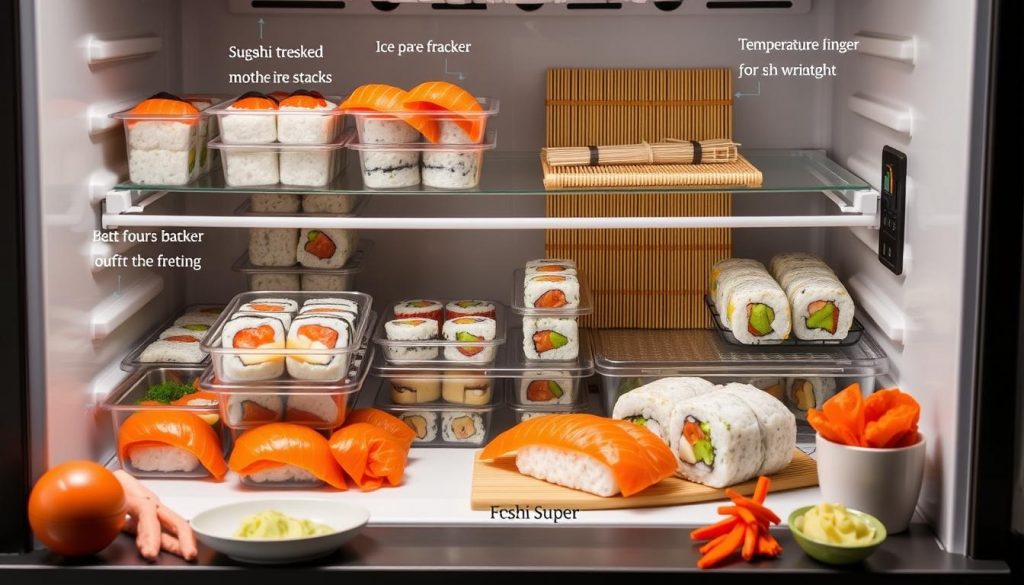Calling all sushi fans! Let’s explore sushi storage and food safety. Ordering extra rolls is tempting, but how long can leftovers stay fresh? We’ll cover proper refrigeration and storage techniques for your favorite Japanese dish.
Sushi requires careful handling. Raw sushi lasts 1-2 days in the fridge. Cooked sushi stays fresh for 3-4 days. These timelines only apply if you store sushi correctly.
Proper storage is crucial. It maintains taste and prevents foodborne illnesses. Follow our guide to enjoy safe, delicious sushi even days after ordering.
At room temperature, sushi has a 2-hour window. On hot days above 90°F, this shrinks to 1 hour. Can’t finish your sushi feast? Wrap it up and refrigerate promptly.
Don’t let good sushi go to waste. Learn proper storage techniques to extend its life. Your taste buds and wallet will thank you!
Key Takeaways
- Raw sushi lasts 1-2 days in the fridge
- Cooked sushi can be refrigerated for 3-4 days
- Consume room temperature sushi within 2 hours
- Proper wrapping is essential for sushi storage
- Always check for signs of spoilage before eating leftover sushi
Understanding Sushi Storage Basics
Sushi is a delicate dish that needs careful handling. Different sushi types have unique storage needs. Proper storage keeps sushi fresh and safe to eat.
Types of Sushi and Their Storage Requirements
Sushi comes in various forms with different storage timelines. Raw seafood sushi should be eaten within 12 to 24 hours. Sushi with cooked seafood or vegetables can last longer.
| Sushi Type | Storage Duration |
|---|---|
| Raw Seafood Sushi | 12-24 hours |
| Cooked Seafood Sushi | 3-4 days |
| Vegetable Sushi | Up to 1 week |
The Importance of Proper Storage Temperature
Storage temperature is crucial for sushi safety. Keep your sushi in the fridge at a consistent cold temperature. This prevents bacterial growth, especially for raw fish sushi.
Food Safety Guidelines for Raw Fish
Raw fish in sushi can grow harmful bacteria if not handled properly. Always refrigerate sushi immediately and eat it within 24 hours. Fresh sushi should smell like the ocean.
A strong fishy or sour odor indicates spoilage. Follow these guidelines to enjoy sushi safely and at its best quality.
How Long Does Sushi Last in the Fridge
Sushi’s shelf life depends on its ingredients and preparation. Let’s explore storage timelines for different sushi types. This guide will help you enjoy your favorite Japanese dish safely.
Raw Sushi Storage Timeline
Raw sushi needs extra care. Eat sashimi and other raw fish sushi within a day. If refrigerated properly, raw sushi lasts 1-2 days.
You can freeze raw sushi for up to a month. However, this may change its texture and flavor.
Cooked Sushi Storage Duration
Cooked sushi typically lasts longer. Sushi with cooked ingredients can stay fresh for 3-4 days in the fridge. Cooked prawn sushi might even last up to a week when stored correctly.
Store leftover sushi in airtight containers to keep it fresh.
Impact of Ingredients on Storage Life
Different ingredients affect sushi’s longevity:
- Vegetable sushi: Lasts up to a week in the fridge
- Cooked salmon or tuna sushi: Good for up to two days
- Sushi without raw fish: May be safe for almost a week
| Sushi Type | Fridge Storage | Freezer Storage |
|---|---|---|
| Raw Fish Sushi | 1-2 days | Up to 1 month |
| Vegetable Sushi | Up to 1 week | Up to 2 months |
| Cooked Meat Sushi | 3-4 days | Up to 2 months |
For best taste and safety, eat sushi within 24-48 hours of preparation. Always store sushi at or below 41°F to prevent bacteria growth.
“Enjoy your sushi fresh for the best flavor and texture. When in doubt, throw it out!”
Best Practices for Storing Leftover Sushi
Proper sushi storage is key to keeping it fresh and safe. Here are expert tips to help you enjoy your favorite rolls later.
Proper Wrapping Techniques
Wrap leftover sushi tightly in plastic wrap or aluminum foil. This keeps the rice moist and preserves flavors. For extra protection, place wrapped sushi in an airtight container.
Container Selection Tips
Use containers made for sushi storage with separate compartments. This prevents mixing of raw and cooked ingredients. It also helps maintain the quality of different roll types.

Organization in the Refrigerator
Store sushi on the bottom shelf of your fridge. This area has steady temperature and avoids drips from other foods. Keep raw sushi away from cooked items to prevent illness.
Raw sushi lasts about a day in the fridge. Cooked sushi can stay fresh for 3-4 days. Always check for spoilage before eating leftover sushi.
With these tips, you can enjoy your sushi safely even the next day!
Room Temperature Storage Guidelines
Food safety is crucial when it comes to sushi at room temperature. The FDA advises not leaving raw fish out for more than 3 hours. For cooked foods, the time limit is 2 hours.
Properly seasoned sushi rice doesn’t need refrigeration. It resists bacterial growth better than unseasoned rice. However, the 2-hour rule still applies for best safety practices.
Here’s a quick guide for homemade sushi storage:
- Raw fish sushi: Consume within 24 hours
- Cooked fish sushi: Safe for up to 3 days in the fridge
- Vegetable sushi: Can last up to a week when refrigerated
In warm rooms (above 90°F or 32°C), cut these times in half. When unsure, refrigerate or discard sushi to stay safe.
“Food safety isn’t just about following rules. It’s about protecting our health and enjoying our meals worry-free.”
Follow these guidelines to enjoy sushi safely. Trust your senses when checking food quality. If something smells off or looks slimy, it’s best to throw it out.
Signs of Spoiled Sushi
Spotting spoiled sushi is vital for food safety. Let’s explore key indicators that show when sushi has gone bad. Knowing these signs helps maintain sushi quality.
Visual Indicators
Fresh sushi should have vibrant colors. If you see these signs, it’s time to discard your sushi:
- Mold growth
- Dull or faded appearance
- Discoloration of fish or rice
- Slimy texture on fish or rice
Smell and Texture Changes
Your nose and touch can detect spoiled sushi. Be alert for these warning signs:
- Sour or pungent odors
- Overly fishy smell
- Sticky or slimy fish texture
- Hard or mushy rice
When to Discard Sushi
Follow these guidelines for optimal food safety:
| Sushi Type | Refrigerator Storage | Room Temperature |
|---|---|---|
| Raw Fish Sushi | 24 hours | 2 hours max |
| Cooked Seafood Sushi | 3-4 days | 2 hours max |
| Vegetarian Sushi | 5-7 days | 4 hours max |
If you’re unsure, it’s best to throw it out. Eating spoiled sushi can cause food poisoning. Trust your senses and put your health first.
Safe Storage Methods for Different Sushi Types
Proper storage keeps sushi fresh and safe to eat. Let’s look at how to store various sushi types. These methods will help maintain taste and quality.

Nigiri and sashimi are delicate and need special care. Eat these raw fish sushi types within 24 hours. Store them apart from other sushi to keep their shape.
Maki rolls last a bit longer. Rolls with cooked or veggie fillings can stay good for 48 hours. Raw fish rolls should be eaten within a day. Wrap each roll on its own to keep it fresh.
Vegetarian sushi stays fresh longer than fish-based types. These plant-based options can last 5-7 days in the fridge. Keep all sushi below 40°F (4°C) to slow bacteria growth.
| Sushi Type | Fridge Life | Storage Tips |
|---|---|---|
| Nigiri | 24 hours | Store separately, consume quickly |
| Sashimi | 24 hours | Keep chilled, eat within a day |
| Maki Rolls (cooked/veggie) | 48 hours | Wrap individually, refrigerate promptly |
| Maki Rolls (raw fish) | 24 hours | Consume quickly, store at coldest part of fridge |
| Vegetarian Sushi | 5-7 days | Use airtight containers, check freshness daily |
For best results, use airtight containers in the coldest part of your fridge. Refrigerate sushi within two hours of making it. This keeps it safe to eat.
Follow these tips to enjoy your favorite sushi while keeping it fresh. You’ll maintain its quality and flavor for longer.
The Impact of Ingredients on Shelf Life
Sushi ingredients’ shelf life affects food safety and quality. Let’s explore how different components impact storage time and freshness.
Raw Fish Considerations
Raw fish is the most delicate sushi ingredient. Sashimi and nigiri last only 24 hours when refrigerated. This short window ensures optimal freshness and safety.
Maki rolls with raw fish can be stored for 1-2 days in the fridge. Proper refrigeration is key to maintaining their quality.
Rice Storage Factors
Sushi rice affects overall quality. When refrigerated, it can become dry and lose its texture. This impacts the taste of leftover sushi.
For the best quality, eat sushi with rice within 24-48 hours. After that, the rice may not be as enjoyable.
Vegetable Component Storage
Vegetable ingredients in sushi generally last longer. Maki rolls with only vegetables can stay fresh for up to 2 days. Veggies help extend the storage time of sushi rolls.
Sushi rolls with cooked ingredients or vegetables may last up to 48 hours. Proper storage is essential for maintaining their quality.
| Sushi Type | Refrigerator Shelf Life | Impact on Overall Storage |
|---|---|---|
| Sashimi/Nigiri | 24 hours | High |
| Maki Rolls (Raw Fish) | 1-2 days | Medium |
| Vegetable Rolls | Up to 2 days | Low |
Store sushi in airtight containers below 40°F (4°C) for best results. This slows bacterial growth and maintains freshness. Keep sushi pieces separate to prevent sticking.
Professional Tips for Maximum Freshness
Sushi freshness is crucial for a great dining experience. Let’s explore storage techniques and temperature management methods used by top sushi chefs. These tips will help keep your sushi at its best.
Restaurant-Grade Storage Techniques
Sushi chefs use commercial-grade plastic wrap for tighter sealing. This keeps sushi fresh longer and prevents drying out. Store different sushi types separately to maintain individual flavors and textures.
Temperature Control Methods
Temperature management is vital for sushi freshness. Use a refrigerator thermometer to keep your fridge at 40°F (4°C) or lower. For short-term storage, try ice packs to maintain optimal temperature, especially for raw fish sushi.
| Storage Method | Temperature | Max Storage Time |
|---|---|---|
| Refrigerator | 40°F (4°C) or lower | 24 hours |
| Room Temperature | 68°F-72°F (20°C-22°C) | 2 hours |
| With Ice Packs | Below 40°F (4°C) | 4-6 hours |
Sushi is best enjoyed fresh, even with professional storage techniques. Consume refrigerated sushi within 24 hours for the best taste and quality. These tips will ensure your sushi stays fresh and delicious, just like at your favorite restaurant.
Conclusion
Proper sushi storage is crucial for freshness and safety. Raw sushi should be eaten within 24 hours. Cooked varieties can last up to 2 days in the fridge.
Keep sushi below 40°F (4°C) to slow bacterial growth. Watch for signs of spoilage like discoloration, bad odors, or slimy textures. When in doubt, throw it out.
Store sushi in airtight containers and eat it soon. Refrigerate leftovers quickly. Follow these tips to enjoy sushi safely and deliciously.




